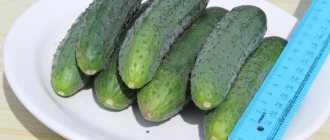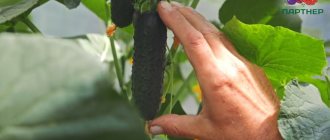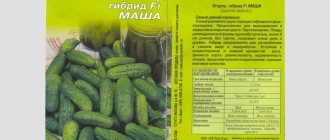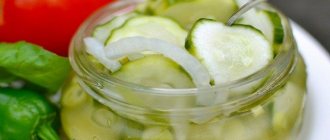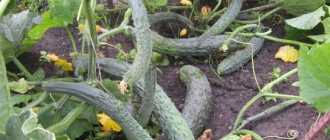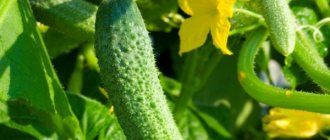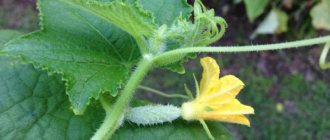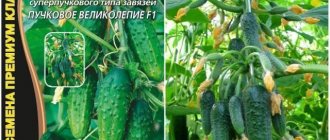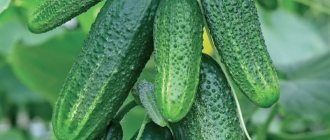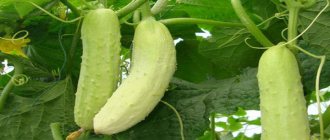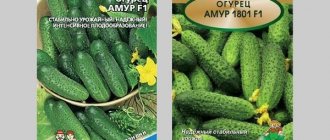It is worth starting the description of the Barabulka f1 cucumber variety with the fact that its characteristics classify it as mid-season. The standard ripening period is 42-48 days. This is a domestic variety that entered the market in 2007. Red mullet cannot boast of record yields, but at the same time, it has excellent taste, marketability and resistance to a wide variety of climatic conditions.
Description of red mullet cucumbers
Red mullet cucumbers are quite versatile; they are suitable for growing both in open ground and in greenhouses. The variety loves warmth and light, and suffers greatly in dark areas. It feels best under film and in greenhouse conditions.
Red mullet bushes are small, branch abundantly, the foliage is bright green. The cucumbers themselves are 11-12 cm in length, weigh from 100 to 110 g. The skin on them is dark green, with narrow, frequent white stripes and whitish spines. The pubescence is medium, the shape of the green is cylindrical. The average yield of the variety, according to the description, is 13-15 kg/m². Red mullet has a pleasant taste; it is suitable for canning and salads.
Features of the variety
The variety “Rabulka F1” does not require pollination by bees, has a predominantly female type of flowering, which is why it is suitable for cultivation both in open ground and in greenhouse conditions. The plant has strong branching, and up to 12 ovaries are formed in one leaf axil, most of which occur at the nodes of the central stem. The leaves have a characteristic green color and are medium in size. The total yield from one bush is up to 15 kg. The first fruits can be collected 43-38 days after the start of germination. Harvesting takes a long time – up to two months.
Zelentsy varieties "Rabulka F1" have a cylindrical shape with large tubercles. The fetal cervix is practically absent. The skin is dark green, and the top of the fruit is lighter in color. Almost the entire area of the fruit contains small white thorns. The length of a mature fruit is up to 12 cm. The weight of one cucumber is up to 150 grams.
What cucumbers of the Barabulka F1 variety look like
Mullet F1 cucumbers are an achievement of Russian breeders, specifically specialists who have long earned the trust of gardeners. The funny and atypical name for garden crops is due to the similarity of the fruits to fish, which have the same name. The hybrid has been listed in the Russian State Register since 2007; its cultivation is recommended throughout the European part of Russia (from the North to the Black Sea region and the Caucasus) in greenhouses and greenhouses. But practice has shown that the Red Mullet F1 cucumber is able to adapt to less than optimal weather conditions and produces a good harvest in regions with a more severe climate.
Red mullet F1 is a relatively new cucumber hybrid, quickly appreciated by Russian gardeners
The hybrid is parthenocarpic (self-pollinating). Weather has little effect on the process. The participation of bees and the help of a gardener for the formation of ovaries is also not needed. The latter is especially valuable when cultivated in a greenhouse.
The main problem for a gardener when growing cucumbers in a greenhouse is their pollination; when planting the hybrid Red Mullet F1, this question disappears by itself
Red mullet F1 is an early ripe cucumber. It takes 43 days for the first greens to ripen, counting from the moment the shoots appear. Mass fruiting begins after 48–50 days. During the season, an average of 14.8 kg/m² is collected; with quality care, the figures rise to 20 kg/m² (6–7 kg per bush).
The fruits of the Red Mullet F1 cucumber ripen quite quickly, you can pick them before reaching full ripeness, getting gherkins
Fruiting is extended, lasting at least two months. When cultivated indoors, the fruits are harvested before the end of September or even until October. So many fruits are removed at one time that there is enough of them for an amateur gardener, for example, for retail sale or for a large batch of homemade preparations.
Red Mullet F1 cucumbers are distinguished by their yield and duration of fruiting
The bush is indeterminate (its height has no artificial restrictions), intensively branching. The type of flowering is female, the ovary is bouquet. Each node produces 3 or more fruit ovaries (maximum 12). The leaves are not large, there are not very many of them.
The indeterminate nature of the plants means that the growth of Red Mullet F1 cucumber bushes is not limited in any way.
The fruits are one-dimensional, regular cylindrical in shape, with pronounced tubercles along the entire length. Against the general dark green background, short, blurry whitish streaks are visible in the lower third of the cucumber. Closer to the stalk the skin becomes slightly lighter. The edge is also light, not too thick. The approximate mass of greens is 95 g, length is no more than 10–12 cm.
Cucumbers skipped by the gardener retain their size, tenderness of the skin and presentable appearance.
Red Mullet F1 cucumbers that are not picked on time do not turn into “zucchini” and retain the typical appearance and taste of the variety
The taste of Red Mullet F1 cucumbers deserves exceptional praise. The pulp is sweetish, with a pronounced aroma, very juicy and crispy. The absence of bitterness is “innate.” The seeds are small, almost imperceptible when eaten. Zelentsy can be used in any way you like. They are very good both fresh and homemade pickles and marinades.
Pickled cucumbers Red Mullet F1 retain their shape, pulp density and, most importantly, their characteristic crunch.
According to the State Register, Red Mullet F1 cucumbers are resistant to powdery mildew and tolerant to downy mildew (downy mildew). The manufacturer claims relative resistance to these diseases. Growing practice and reviews from gardeners indicate that the hybrid (especially with proper agricultural technology) is highly resistant to other diseases and rarely suffers from fungi, bacteria, viruses, and insects.
Characteristics of the variety
The Red Mullet f1 cucumber appeared in Russia at the beginning of the 21st century. This name for the variety did not appear by chance. The thing is that its fruits, when ripe, very much resemble the fish of the same name. The Red Mullet f1 appeared in the national registry only at the beginning of 2008.
If you believe the description, then this type of cucumber can be grown anywhere in the country. It does not depend on climatic conditions, because it can be planted quite easily in greenhouses or in open ground.
Description of the plant
This is a parthenocarpic plant that does not require pollination by bees at all. It can self-pollinate and produce new fruits. This is indicated by the sudden appearance of yellow flowers on the tops.
Flowering type is female only. The Red Mullet cucumber is a very good variety that belongs to indeterminate crops. This is an early ripening plant. The growing season is only one and a half months after the appearance of the first shoots. Has a high branching characteristic. The height of the bush is average. Many ovaries can appear in one sinus at the same time.
Description of the fruit
The Red Mullet type of cucumber is characterized by the fact that its fruits are regular in shape and have a slight resemblance to a cylinder. Their skin has frequent and small white bumps. Pubescence is presented in the middle view.
The peel has a bright green tint. Near the nose the color is predominantly light green. If you look closely, you can see that there are frequent white stripes on the top of the fruit. The length of each cucumber does not exceed 15 cm. The yield is quite high, and about 20 kg of high quality crops are harvested from 1 m2 of land. If we consider only 1 bush, then 5 kg of fruits are collected from it. The weight of one fruit is most often 200 g.
This is a universal type that can be used in various spheres of human activity. It can be consumed not only fresh or in salads. This is an ideal option for pickles and preservation.
Characteristics of red mullet F1 cucumbers
Barabulka cucumber is an early fruiting hybrid from Russian agro. The variety was tested and in 2007 included in the State Register of the Russian Federation and recommended for planting in the Northern, Northwestern, Central regions, the Volga region and the North Caucasus.
Varabulka F1 variety is classified as parthenocarpic. Pollination of crop flowers occurs without the participation of insects. Parthenocarpics bear small, even fruits that do not turn yellow and are stored and transported for a long time.
The plant is indeterminate and branches well. Its flowers are female. The leaves are green and medium in size. 8-12 ovaries are formed in the leaf axil. Most of the fruits are located near the central shoot.
According to the description, reviews and photos, the fruits of the Red Mullet cucumbers have a number of features:
- cylindrical shape;
- large tubercles;
- length 10 - 12 cm;
- weight 90 - 100 g;
- dark green color;
- light stripes;
- white thorns;
- short neck.
Varabulka F1 variety is intended for protected soil. It is grown in private farms, greenhouses and greenhouses.
Characteristics of the bush
The plant is parthenocarpic - insect pollination is not required. The flowers are mostly female. Suitable for cultivation in open and closed soils.
Description of variety, bush:
- Has strong branching.
- Medium-sized plant.
- The number of ovaries ranges from 3 to 12.
- Many ovaries are formed near the main stem.
- Leaves are medium sized.
- The color of the leaves is bright green.
Resistance to pests and diseases
The Barabulka cucumber variety has a fairly stable immunity. Downy mildew, leaf mosaic, and powdery mildew are not observed on cucumbers. If the greenhouse is not ventilated and the humidity is high and the temperature is low, anthracnose may develop.
To combat fungal infection, bushes are treated with colloidal sulfur, and in the spring for prevention - with copper sulfate. In greenhouses, insects do not parasitize cucumbers. The Whitefly caterpillar is found in the OG. Pests are collected manually, and in case of large clusters they are treated with “Commander”.
Growing principle
The plant is unpretentious in care.
It is not necessary to put a lot of effort into growing the red mullet f1 cucumber hybrid. This variety is not picky about care or planting principles. Seeds should be planted in late April. It is best to do this in a greenhouse.
As soon as it was noticed that about 2 leaves appeared on the main stem, you can begin planting in open ground. Usually, only 1 month is enough to form this number of leaves. A distance of 60 cm should be maintained between rows. The same distance should be used between holes.
Productivity
From 1 m2 they collect 12-14 kg.
Pros and cons of the Red Mullet F1 cucumber variety
The advantages of growing cucumbers of the Barabulka F1 variety are recognized:
- good taste;
- high productivity;
- resistance to diseases;
- universal purpose.
Yield indicators
The red mullet cucumber has a high yield. One bush produces 6–7 kilograms of cucumber. As a result, up to 15 kilograms of cucumber can be harvested from 1 square meter per season.
It is worth noting the planting’s resistance to disease:
- Powdery mildew.
- Downy mildew.
- Cladosporiosis.
See also
How to plant cucumbers and corn in open ground, is it possible? Read
Disease resistance is the basis for a good harvest.
Landing Features
Cucumber Mullet f1 can be planted in different ways: both seed and seedlings. The main thing is that the soil is warm enough at the time of planting, and the weather is sunny and warm. This variety, according to the description, loves light and ripens much faster in warm climates.
Sowing time
Seedlings of the Barabulka variety of cucumbers grow quickly. Young shoots are planted in a greenhouse after 3 leaves have formed on the stem. From the moment the seeds are planted until the plant is planted, 25 days pass. Cucumbers are planted on the site if the ground has warmed up to +14 0 C. Approximately, the sowing of seeds occurs at the beginning of April. The seedlings are transferred to an open area in mid-May. Seeds are planted in a greenhouse in early May, in an unprotected area 14 days later.
Selecting a location and preparing beds
The site is chosen to be open to the sun; temporary shading is allowed. A prerequisite is that the soil must be well drained; nearby groundwater is not suitable for the variety. Cucumbers do not react well to the north wind, so they take protective measures against drafts.
In the fall the site is dug up. If the soil is acidic, add lime or dolomite flour. Remains of weeds are removed, manure and ammonium nitrate are added. In the spring, the bed is loosened and re-fertilized with organic matter.
Planting seeds
The variety can be planted with seeds in open ground or a greenhouse only if the climate is sufficiently warm and stable. The seeds are added, according to the description, at the end of April, into previously prepared holes.
3 days before planting, the holes are filled with hot water. Before sowing, the seeds themselves are soaked for 40 minutes in a saline solution and disinfected with a solution of potassium permanganate. To ensure that cucumbers develop good immunity, they can be further hardened on the bottom shelf of the refrigerator.
Planting seedlings
The most common and safest way to plant cucumbers. Red mullet f1, according to the description, is planted after the appearance of 4-5 leaves, when the height of the sprouts reaches 8-10 cm. Before transplanting into the ground, red mullet seedlings should be treated with fungicides.
For planting work, it is recommended to choose a clear, windless day. Cucumber sprouts are transferred to the soil very carefully - their roots are quite fragile and easily damaged.
How to plant correctly
Cucumbers do not tolerate transplantation well, so the seeds for seedlings are planted in peat cups. In order not to injure the root, the seedlings are placed on the site together with the container. A hole is made 5 centimeters larger than the peat cup, and the seedling is filled to the bottom leaves. 3 seedlings are placed per 1 m2. For seeds, make a hole 3.5 cm deep. The planting pattern is the same for the exhaust zone and the closed area. Row spacing – 45 cm, distance between bushes – 35 cm.
Hybrid agricultural technology
Cucumbers are grown both in greenhouses and in open ground. In both cases the yield is equally high.
To get a good harvest of cucumbers, it is recommended to start preparing the beds in the fall. First of all, you need to choose the right place to sow the seeds.
Cucumbers are planted in semi-shaded areas of the garden. To artificially create shade, tall crops are planted on both sides of the beds.
Advice ! It is not recommended to plant melons and melons next to cucumber beds, which attract dangerous insects and infectious agents. In the immediate vicinity of Barabulka, only those cucumber varieties that are immune to the same diseases are planted.
In the fall, the beds are dug up and cleared of plant debris. Weeds and cultivated tops are crushed and buried in the ground. In the spring you will get fertile soil.
Another way to make the soil more fertile is to bury chopped peels (fresh and rotted) of bananas in it in the fall. Throughout the year, the peelings of this fruit are placed in a barrel standing on the street.
In spring, for every 1 sq. m add 25 g of superphosphate and ammonium nitrate. The soil is watered with a hot solution of copper sulfate.
Cucumbers love soil with low acidity levels. To test the acidity of the soil, use litmus paper. Another way: collect some earth in a bucket and sprinkle it with soda. After this, the mixture is poured with a small amount of water and the result is observed. If bubbles appear, it means the acidity is increased.
To reduce the acidity of the soil, add dry lime or ash. Sand is added to loosen the soil.
Landing
Cucumbers are grown by seed and seedlings. In the second case, the harvest will appear earlier. The seedless method is suitable only for the southern regions.
If the seeds are coated with nutrients, then they are sown in the ground without prior preparation. The manufacturer marks the processed seeds with a bright color. Information about pan coating or glazing of seeds is indicated on the packaging.
The hybrid material is often processed and calibrated in production, so preparation is not necessary. If the planting material was not processed in the factory, this is done at home. This process includes the following steps:
- The seeds are carefully examined. All specimens must be dense, with the same color.
- A month before planting, calibrated planting material is placed in a warm place. Warmed seeds germinate faster.
- To speed up the germination of planting material, it is soaked in a growth stimulator for a day. Both store-bought medications (Epin) and a homemade solution prepared from a full teaspoon of honey and a glass of water are suitable.
- Most gardeners prefer to germinate planting material before sowing. It is wrapped in a damp cloth (it should remain damp throughout germination) and put in a warm place for 3 days.
- To harden the seeds, they are placed in the refrigerator for 48 hours.
Seed method
The seed method of growing Red Mullet is possible only in areas with a warm climate. The time for sowing seeds depends on the region:
- southern regions – end of April;
- cities with a temperate climate - end of May;
- northern part of the country – first half of June.
The holes are dug in rows, in a checkerboard pattern. Use a 50x50 scheme.
2 days before sowing the seeds, a 5 cm layer of rotted manure and the same amount of soil are placed on the bottom of the hole. The ingredients are mixed. The rest of the space is filled with garden soil. The prepared wells are poured with boiling water.
Before sowing the seeds, the holes are watered with settled water at room temperature. Since the germination rate of Red Mullet seeds is close to 100%, 1 seed is sown in each hole to a depth of 4 cm.
The crops are covered with film. It is opened slightly for ventilation every day. Crops are watered as the soil dries out. The film is completely removed after 2-3 weeks. If there is a threat of night frosts, the plants continue to be covered overnight.
Seedling method
The seedling method of growing cucumbers is considered the most reliable. It allows you to get an early harvest and is suitable for all regions. In this case, the time for sowing seeds also depends on climatic conditions:
- southern regions – early April;
- cities with a temperate climate - end of April;
- northern part of the country – first half of May.
It is recommended to grow cucumbers immediately in individual pots. Both purchased plastic and peat containers and homemade pots are suitable.
The most unusual containers for growing seedlings:
- Peels of oranges and grapefruits. The pulp is removed from the fruit, leaving the peel intact. Make a large hole on top (like a pot), and a small drainage hole on the bottom. There is no need to remove such pots when placing them in a permanent place; they will unfold, providing the plants with nutrients.
- Eggshell. To do this, make a hole in the top and bottom of the eggs and blow out all the contents. A piece is broken off at the top of the shell to create a large enough hole. The shells are filled with soil and placed in trays (for eggs). When transplanting seedlings to a permanent place, the eggshells are split into large pieces. They will be needed for pest control.
Soil for seedlings is bought in the store (universal soil mixture) or prepared independently. To do this, mix 1 part of humus and garden soil with 0.5 parts of sand or sawdust. Add 1 tbsp to a bucket of composition. l. ash and 1 tbsp. l. nitrophoska.
Care
From Barabulka’s description it is clear that the cucumber does not require complex care, it is tolerant of arid climates, and its cultivation does not require complex manipulations. In optimal conditions, with timely fertilizing, watering and weeding, it can produce an excellent harvest without any problems.
Watering
The Mullet f1 variety must be watered with settled warm water, non-mechanically, ideally using the drip method. The ideal time for watering is early morning or evening at sunset. Abundant watering is especially important at the stage of active growth of bushes and during the flowering period.
Water the cucumbers as the liquid evaporates, strictly at the root, avoiding drying out of the soil and stagnation of water.
Top dressing
Red mullet f1 is very susceptible to fertilizers. The first feeding of the cucumber is carried out 5 days after planting - a solution of mullein and nitrate is added. Then fertilizing is repeated 2-3 times - at the moment of formation of buds and tying greens.
Fertilizers are applied at the root of the red mullet. Potassium salt, ash, manure and superphosphates are best suited for this purpose. To stimulate the formation of ovaries, organic fertilizers that saturate the cucumber with oxygen are ideal.
Tying and shaping bushes
Red mullet, as described, tends to grow, so bushes need to be formed as early as possible. In a greenhouse, cucumbers are tied up a week after planting seedlings, in open ground - after 10-12 days.
The bush is formed into one stem, all side shoots need to be pinched as soon as their growth exceeds 20-30 cm. The top is also pinched - when the bush grows 1.3-1.5 m.
Hilling
Timely hilling is necessary for cucumbers to protect them from temperature changes - the Red Mullet variety is especially sensitive to them. The first time the bushes are covered with earth immediately after planting, or after 4-5 days - it all depends on the weather. Then, the cucumbers are hilled a second time when they grow 16-20 cm - they are covered with the lower tier of leaves.
Harvesting and application
The first harvest of red mullet is obtained in May or June. Plants bear fruit until the first frost.
Cucumbers are stored in a cool, damp place. If you plan to store the crop for a long time, then the greens are regularly sorted, removing withered and rotten fruits.
Red mullet cucumbers are universal in use. They are suitable for canning, pickling and fresh consumption.
Advantages and disadvantages
Pros:
- high productivity;
- pleasant taste;
- early and friendly ripening;
- excellent marketability and appearance;
- low susceptibility to diseases;
- resistance to stress and tolerance of unfavorable changes in weather;
- possibility of universal use.
Minuses:
- need for fertilizing.
The advantages of this variety include:
- excellent taste and compact size of the fruit (convenient for pickling);
- early ripeness;
- high productivity;
- long fruiting period;
- resistance to diseases and weather changes;
- ability to self-pollinate.
The variety has no obvious disadvantages. But you need to take into account that the seeds of the Red Mullet, like any f1 hybrid, do not have the qualities of the initial variety - completely different cucumbers can grow from them.
The main positive qualities of “Barabulka” are:
- Self-pollinating abilities;
- Excellent taste characteristics;
- Immunity to diseases;
- High yield;
- Good germination;
- Early ripening;
- Long period of fruiting;
- No tendency to outgrow;
- Commercial appearance;
- Shade tolerance;
Gardeners did not identify any particular shortcomings.
- Frost resistance;
- Resistance to mechanical damage.
“Rabulka F1” is considered a universal variety - cucumbers can be eaten fresh for salads and cold dishes, and the fruits are also suitable for pickling and pickling. The big advantage of this hybrid is the taste of the fruit, both fresh and canned. The plant is resistant to various diseases and temperature changes, but in this case the yield is significantly reduced. There is good seed germination and uniform fruiting of the bushes.
The main advantages of this type include the following characteristics:
- versatility in application;
- high levels of taste and juiciness;
- resistance to viral and fungal infections;
- independence from climatic conditions and temperature indicators;
- the seeds germinate quite well;
- all bushes produce uniform yield.
No particular deficiencies were found in this variety.
Diseases and pests
Red mullet f1 is a variety that has good immunity against many dangerous diseases of cucumbers. However, insect pests can cause serious damage to the variety’s harvest – a gardener should be especially attentive to this factor. It is better to plant cucumbers away from crops that are vulnerable to ants and aphids, and to thoroughly treat the area before planting.
Downy mildew
Downy mildew appears on cucumbers as yellowish or brownish polygonal spots. It affects the ovaries, making them small and twisted.
As soon as signs of the disease are noticed, Red Mullet cucumbers are temporarily stopped watering and treated with a solution of kefir and iodine (1 liter of the first and 2 drops of the second). A phytosporin solution will help stop the spread of bacteria.
melon aphid
A small greenish-white parasite eats the leaves of cucumbers, sucking the life juices from the plant. The main signs of aphid infestation are a sticky coating, drying out and curling of the leaves.
If the bushes of the Red Mullet variety are not too damaged, and there are few pests, treatment with wormwood infusion or a solution of 9% vinegar will help. In case of severe infection, radical agents are needed - such as neonicotinoids (Vector, Ratibor, Dantop), or pyrethroids (Kinmiks, Sherpa, Decis).
Ants
These insects, judging by the description, not only harm the cucumbers themselves, but also “bring” aphids with them. To get rid of ants, you must first find and destroy their nests. Then the plants of the variety are treated with solutions of Karbofos, Muratox, Delicia, etc. The best prevention against pests is ideal cleanliness and order in the beds - no plant or wood residues, timely treatment with light fungicides and thorough weeding of the rows.
Diseases and prevention
Due to the fact that breeding specialists made sure that this variety has a high level of immunity, it is not susceptible to any diseases. This species carries not only viral infections, but also fungal spores.
As a preventive measure, you should regularly examine the foliage of the plant. It is quite possible that parasites or insects will fly in to profit. At this point, it is easy to deal with them with your own hands, without resorting to the help of chemicals.
Gardening tips
Gardeners advise remembering a few rules. They will help you get a rich harvest and avoid many problems:
- It is recommended to tear off the leaves at the bottom of the bush. This promotes better air exchange.
- Before the inflorescences appear, cucumbers are watered 2 times a week and sprayed. After the flowers appear, water is poured under the root daily. You can't get pollen wet.
- The day before fertilizing, the beds are watered abundantly.
- Cucumbers are planted and watered early in the morning or at sunset. If this is done during solar activity, burns will appear on the leaves.
- When transplanting seedlings to a permanent location, some gardeners coat the roots of the plants with a thin layer of honey. This will help cucumbers quickly adapt to new conditions and act as additional protection against fungal infections.
- If several varieties of cucumbers grow nearby, it is recommended to place cobblestones with different patterns on their border. This will decorate the garden and prevent confusion.
- As an additional feed for seedlings and adult plants, you can use the water in which vegetables and eggs were boiled.
